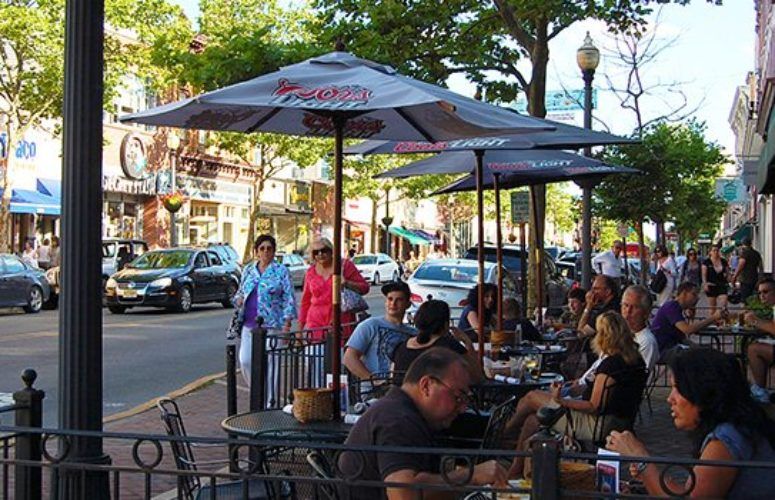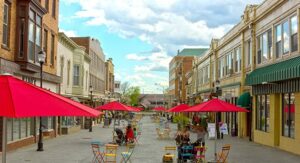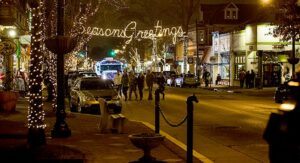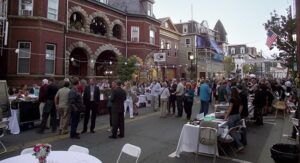
Under the Radar: New Jersey Gems
The state’s largest cities are fine, but smaller towns also offer amenities that attract visitors.
By Vince Baglivo, Contributing Writer On Jul 24, 2015New Jersey is the nation’s fourth smallest state. Yet, somehow, 565 municipalities coexist within its less than 9,000 square miles. In the shadow of New York City and Philadelphia, and with local and regional challenges to face, many municipalities have struggled through the prolonged economic downturn.
Yet, others have seen their downtowns grow and thrive. What factors are influencing their success or continued tough times in the wake of the Great Recession and increasing competition among communities for residents, visitors, entrepreneurs and investors?
There are noteworthy communities statewide that fall off the radar screen when it comes to recognition across New Jersey and beyond. Some boast top dining and shopping districts. Others benefit from mass transit connectivity or a thriving arts community. While varied and distinct in terms of location and local flavor, common attributes contribute to their success or failure.
One characteristic shared by these standout communities is effective partnerships. Whether it is collaboration between businesses that work together to market and promote, public-private partnerships between municipalities and managed districts, or collaboration between developers, agents of change like NJ Transit and local stakeholders, New Jersey’s gems have effective partnerships at the core of their accomplishments.
“What distinguishes a successful downtown from a challenged downtown is the presence of a formal multi-sector partnership that brings together key stakeholders,” says Seth A. Grossman, Ph.D., director of Rutgers University’s Institute of Business District Management at the School of Public Affairs & Administration. Grossman is also the author of “Partnership Governance.”
Partnerships are not only the foundation of all communities, but also work to balance the inherent strengths and weaknesses of various stakeholders, as well as mitigate the associated risks of planning and implementing revitalization and redevelopment efforts that are bridged by both the public and private sectors,” he adds.
Here is a review of a handful of these “Hidden Gems”
All Roads Lead to Somerville

Once a scruffy side street off of Somerville’s main drag, Division Street is a multi-block area that has been transformed into a welcoming pedestrian center with flexible design elements that facilitate everything from a farmer’s market, jazz nights out for adults, kid friendly entertainers and movies under the stars. Surrounding businesses now sing the praises of the concept that draws both locals and visitors that frequent the events as well as nearby stores and restaurants.
Wolfgang’s Steakhouse has locations in New York City, Tokyo, Miami, Beverly Hills, Waikiki – and Somerville. Wolfgang’s, along with other desirable brand names like Starbucks, are emblematic of the dynamic changes that are turning a formerly sleepy suburban downtown into a national model for effective place-making. Somerville is arguably undergoing the most dramatic reinvention of any town, statewide.
Hundreds of new residential units are under construction, approved and planned. Redevelopment of the former Landmark Shopping Center downtown continues, with mixed-use buildings drawing residents, restaurants and retailers along with anchors like ShopRite and Chase Bank. New projects in the works take advantage of Somerville’s rail connections that link the blossoming town of 12,000 for visitors and residents alike, drawn by the vibrant street scene featuring inviting boutiques, great dining options and year-round special events and activities of note for both adult and family-friendly audiences.
“Somerville has always been a center of commerce, transportation and community for the Central Jersey region,” notes Mayor Brian Gallagher. “More than ever, with the changes and improvements that have taken place through redevelopment efforts based on the vision and input of professional planners, local residents, business owners and other stakeholders, all roads lead to Somerville.”
When the economic doldrums caused by the Great Recession led other municipalities to pull back or cancel revitalization plans, Somerville pushed on, albeit with adjustments based on market conditions, Mayor Gallagher adds. Now, apartments and single family homes are in demand, developers and retailers are competing for prime downtown commercial space and the dining scene has never been more dynamic.
An $18-million investment by NJ Transit to expand and improve the Somerville Train Station contributes to the continuing transformation. New businesses and restaurants are opening at a record pace, and storefront vacancies have dropped to nearly zero. Of note, downtown Somerville has become equally attractive to urban village-focused millenials as well as empty nesters and retirees intrigued by the convenience and amenities at their doorstep.
An innovative approach to redefining downtown city life on Division Street perhaps best illustrates why Somerville is alive with energy and excitement. Once a scruffy side street off of Somerville’s main drag, a multi-block area has been transformed into a welcoming pedestrian center with flexible design elements that facilitate everything from a farmer’s market, jazz nights out for adults, kid friendly entertainers and movies under the stars. Surrounding businesses now sing the praises of the concept that draws both locals and visitors that frequent the events as well as nearby stores and restaurants.
Recently, representatives of the Downtown Somerville Alliance (DSA), a public-private partnership between the city and local business and property owners, were invited to speak at the Congress for the New Urbanism (CNU) annual convention in Dallas about the challenges and ultimate success of the Division Street place-making effort. CNU promotes sustainable communities that encourage mixed-use neighborhood development and better quality of life.
“With the hard work, commitment and contributions of many dedicated people, we are building a dynamic Somerville that is attracting new residents, business owners and investors drawn by the appeal of a livable, connected and vibrant community,” adds DSA Chairman Tom Genova.
Lambertville, the Delaware and a Bridge

A parade on Bridge Street in Lambertville leading into New Hope, Pennsylvania.
George Washington’s daring winter rowboat crossing of the Delaware River is immortalized in American history. Today, people are more likely to traverse the historic waterway on bridges linking several inviting river towns in both New Jersey and Pennsylvania to shop, dine and enjoy arts and culture.
While Lambertville may be under the radar, its charms are certainly no secret. Pete Genovese, who writes about great places to eat and visit around New Jersey for the Star-Ledger and NJ.com, recently named Lambertville number one among his top 10 small towns in the Garden State.
In fact, visitors have made Lambertville, its sister town across the Delaware, New Hope, and other nearby communities on both sides of the River including Frenchtown to the north, a top regional destination. Other than the Delaware River itself, which draws thousands of visitors who fish, canoe, kayak and tube its waters, what sets the river towns apart from other New Jersey destinations?
“Quite simply, nowhere else do the arts, shopping, dining and nature flow together more than in our Delaware River towns,” states David B. Morgan, executive director of the Greater Lambertville-New Hope Chamber of Commerce (GLNHCC). “If you can’t find something that speaks to your heart, then it may very well not exist. We have so much that can be reached by a short walk, a scenic bike ride or a short drive. Whether you travel in heels or on a Harley, boat shoes or running shoes, we have it.”
The Chamber is the most obvious example of cooperation between New Hope and Lambertville, as well as the new focus and emphasis of a collective and collaborative approach to destination marketing. Morgan says the towns are connected by a bridge, not separated by a river. The organizations new name, logo and slogan, “Creating Prosperity Together,” emphasize that theme. “We may be separate towns, but we are one community. Our goal is to draw from the strengths presented on both banks of the Delaware to promote our entire region as the best day trip or long weekend,” Morgan adds.
“While our towns have been successful in the past, we need to recognize that many consumers and visitors today aren’t coming for one store, or one restaurant – they are coming to have an entirely new set of experiences,” he continues. “Together, we can provide visitors experiences that they simply cannot have if they only stay in one town or on one side of the river.”
Red Bank’s Rising Tides
The fortunes of Red Bank have risen and fallen throughout its history like the tides of the Navesink and Shrewsbury rivers that bound the borough. The town played a leading role in Monmouth County business and cultural affairs during the 20th century. Then, an economic decline caused by the recession of the mid-1980s inspired the moniker “Dead Bank.” A newfound sense of place and purpose then followed in the 1990s, which earned the redeveloped downtown and its upscale shops and restaurants a reputation as “Red Hot”.
Many credit the 1991 creation of the Red Bank RiverCenter, a special improvement district authorized by the borough and funded by assessments on local business and property owners, as the catalyst to that upswing. With responsibility for the management and redevelopment of Red Bank’s downtown business district, the organization was instrumental, working with municipal leaders, in the planning and implementation of streetscape improvements ranging from better signs and lighting, attractive and distinctive sidewalks, to enhanced parking and landscaping that added curb appeal. An aggressive destination marketing campaign kept the spotlight on Red Bank.
In the years that followed, high-end retailers served a well-heeled clientele, drawing customers from wealthy communities nearby like Rumson and Fair Haven, and throughout the region. The dining scene similarly served sophisticated fare that contributed to the upscale ambiance.
The Great Recession caused many people in New Jersey and elsewhere to cut back on spending. Despite this recalibration, Red Bank’s business community has endured. Many credit the strength of Red Bank’s arts scene as the glue that held things together. The partnership between local businesses and restaurants, the landmark Count Basie Theater and the acclaimed professional, not-for-profit Two River Theater has helped Red Bank survive the downturn and attract new faces to the shopping and dining scene.
Longtime merchants will be joined in late summer or early fall by upscale furniture and housewares retailer West Elm. A diverse dining scene has exploded, in the words of Red Bank Town Center Executive Director James Scavone, with several new restaurant openings in the past year alone.
“Our reputation as a center for the performing, visual and culinary arts has also helped us attract smaller arts related businesses, as well as retailers from surrounding towns who wanted to be a part of our downtown business community,” Scavone states. “In some ways, the economic crisis may have actually benefited Red Bank, attracting a larger local crowd who appreciate New York City style and quality, but can find it here while saving time and money and supporting local businesses.”
Collingswood is Calling

Christmas time in downtown Collingswood.
Collingswood’s longtime Mayor Jim Maley says the turning point on the road to revitalization for his community was the unconventional purchase in 1996 of the failing, high vacancy, broken down Sutton Towers Apartment Complex from its bankrupt owner. Miles from Center City Philadelphia, and linked by mass transit connections, Collingswood was facing a tipping point towards urban problems and decay, and needed to make some bold decisions.
A multi-million-dollar investment by the borough and its partner, Capitol Properties, led to renovations that transformed the derelict complex into a welcoming residential center with more than 1,000 units, including a sizable portion set aside for senior housing.
The sale of the property led to other ambitious efforts, including: A mixed-use development on the site of a former lumberyard; the redevelopment of a dilapidated and condemned former school building into an inviting office complex; and the purchase and redevelopment of other vacant sites to capitalize on the proximity of the nearby PATCO Train station.
“We wanted people to share our belief that things would get better and support our vision,” Maley notes. “That started with the Sutton Towers project, which helped make change easier. Today, people enjoy the connections and convenience that are part of a livable and desirable urban experience. At that time, people were more concerned with big city problems that Camden faced, like public safety.”
While the name Collingswood is often met with blank stares in northern New Jersey, in the state’s southern tier the buzz has been growing for years about the beautiful setting on the Cooper River, the quaint downtown with exceptional shopping and dining and a non-stop schedule of events and activities. Collingswood has also earned a reputation as one of New Jersey’s friendliest towns, with a welcoming attitude towards diverse people and lifestyles that might shock the community’s Quaker founders.
Cass Duffey, Collingswood’s director of community development, serves as a bridge between the municipality and Collingswood’s three business improvement districts. She believes that cooperation between the borough’s stakeholders, like local retailers and restaurateurs doing joint promotions and the support and participation of residents in Collingswood’s year-round special events, helps define the continuing success of the community and the attraction for new residents and businesses flocking to the downtown area. “People are excited and proud to be a part of it, and Collingswood’s success is because the community is a part of it,” she concludes.
Newtown’s Hometown Commitment

A street festival in downtown Newton.
Alex Cable, president and CEO of Thorlabs, a worldwide leader in the optical equipment industry, founded the company in his parents’ Newton basement. Today, the company calls the Sussex County seat home, investing millions to develop a former brownfields site into its corporate headquarters. The company’s commitment extends to support for the local school system, including Newton High School’s award-winning robotics team, in addition to the jobs it creates that support the local economy and community.
“Bringing manufacturing back to a small town in New Jersey; that’s not a story most people expect,” says Newton Mayor Kevin Elvidge. “The town developed a Vision Plan several years back that included key redevelopment areas, like the one where Thorlabs is located, and working with companies to encourage new investment. We are cognizant of costs, but committed to the continued redevelopment of our downtown and other business centers town-wide.”
Recent changes to Newton’s sign ordinance and the upcoming conversion of Spring Street, the heart of the main shopping district, to a one-way only thoroughfare, reflect the ongoing changes to the town that serves as northwestern New Jersey’s downtown. New retailers and a growing dining scene add appeal to the streetscape. Developer Martorana Enterprises’ Grand Villaggio will have 54 townhouse-style condominium units in nine new buildings and an additional six rental units for low and moderate income households when completed.
The historic Newton Theater, restored to its former glory, now hosts acts of national renown. Newton Medical Center, part of the Atlantic Healthcare System along with Overlook and Morristown Hospitals, has also played an important role in Newton’s revitalization, along with Sussex County College. They attract doctors and other professionals to serve a growing patient base in the region as well as students and educators, all supporting the local business community.
The municipalities mentioned are all working hard to revitalize their downtown centers and neighborhoods so that residents and visitors (from far and wide) can enjoy the local ambience, whether it is sidewalk cafes, restaurants and bars that offer live entertainment or the arts, parks or tree-lined streets. A superb quality of life attracts visitors and prospective homeowners … and these towns have it.



